
There is no doubt that airlines rely on their widebodied aircraft for their long-haul operations, especially on high-capacity routes. Passengers look for comfortable cabins on long-haul flights and will often look closely at what the airlines are offering in terms of cabin quality. For the airlines, cost efficiency is crucial, and sustainability presents a huge challenge. Here, we will compare two of the largest airlines in the United States, United Airlines and Delta Air Lines, to determine which airline has the largest widebodied fleet.
Both United Airlines and Delta Air Lines are US legacy carriers with domestic and international routes worldwide. United Airlines is the largest airline in the world by fleet size and flies to 360 destinations across six continents. However, American Airlines is considered the largest in terms of revenue and passenger volume. Delta Air Lines is considered the third-largest airline by fleet size and operates 4,000 daily flights to 275 destinations, according to routes online.
United Airlines Vs. Delta Airlines
United Airlines has 228 widebody aircraft in its fleet and a total of 1,046 aircraft in its mainline fleet. This widebody fleet is made up of 55 Boeing 767-300ER and 767-400ER, 96 Boeing 777-200, 777-200ER and 777-300ER, and 71 Boeing 787-7,787-8,787-9, and 787-10. Delta Air Lines operates its mainline fleet with a total of 992 aircraft, close to the fleet size of United Airlines, and has 177 widebody aircraft. These are made up of the Airbus A330-200, A330-300 and A330-900neo of which there are 79. They also have 38 A350-900 and 60 Boeing 767-300ER and 767-400ER.
Therefore, United Airlines is the carrier with the most widebody aircraft and they are all Boeing. In fact, the airline has the largest widebody fleet in the United States, taking into account all carriers. On the other hand, Delta Air Lines has a more varied fleet operating with both Airbus and Boeing aircraft; interestingly, they both operate the Boeing 767-300ER and the 767-400ER. The Delta Air Lines fleet is younger and more modern, with the A330-900neo and the A350-900.
Both of the legacy carriers operate large fleets for their long-haul operations, so they are often compared and scrutinized. Delta Air Lines is known for being reliable and consistent in comparison to United Airlines, which is recognized for its large network but has fewer onboard amenities. Delta Air Lines offers a good passenger experience, with more legroom, better inflight entertainment, and a more comfortable economy experience.
Current Network And Overall Fleet
Delta Air Lines works to feed its hubs, including Atlanta, Los Angeles, New York, Seattle, and Boston, as well as other major cities in the US. They have one of the largest and most diverse fleets that includes the Airbus A220, the A320 family, the A330, and the A350. On the Boeing side, they have the 717, 737, 757, and the 767. Their top international destinations are London, Paris, Rome, and Cancun.
United Airlines is focused more on transatlantic and transpacific routes, and its network offers more international destinations than any other US carrier. The airline operates a mix of Boeing and Airbus narrowbody aircraft, but its widebody fleet consists entirely of Boeing aircraft. Across both fleets, they operate the Airbus A320 family (A319, A320, A321) along with many variants of the Boeing 737, 757, 767, 777, and the 787. Their Airbus aircraft are just a fifth of the entire fleet. United Airlines’ most popular destinations are London, Tokyo, Beijing, and Sydney.
United Airlines
Data: ch-aviation
United Airlines’ most popular domestic routes are Chicago, Denver, Houston, Los Angeles, Newark, and San Francisco. For Delta, New York, Atlanta, Orlando, Los Angeles, and Honolulu are the busiest domestic routes. Delta Air Lines’s hubs provide access to destinations worldwide. For example, New York (JFK) is the gateway to the Middle East and Europe, Seattle (SEA) is the hub for Asia, Los Angeles (LAX) is a hub for Australasia, and LaGuardia (LGA) is a hub for Canada. Hartsfield-Jackson Atlanta International Airport is the largest hub and is the gateway to Europe, Asia, Africa and South America.
A Comparison Of The Airlines
Delta Air Lines is at an advantage with its young, modern fleet and offers a consistent product, operational reliability, as well as reaches its sustainability goals. The introduction of the One suite business class with its lie-flat beds and privacy doors, the Premium Select premium economy offering and the Boeing 767 cabin refresh show that the airline is focusing fully on improving the passenger experience. However, some of their Boeing 767s are over 20 years old and cannot compete with the Airbus A330neo or the A350.
United Airlines’ current fleet of Boeing 767 and 777 are mostly over 25 years old, are less comfortable than newer aircraft and costly to maintain in comparison. However, their new Polaris Studio business cabin that has lie-flat beds and privacy doors is planned for 2026 on their new Boeing 787-9 Dreamliner aircraft, with at least 30 new aircraft expected by 2027. This product may well be a competitor to Delta Air Lines One suite.
Delta Air Lines
Data: ch-aviation
While United Airlines has ordered 142 Boeing 787-9, there are delays in delivery due to supply chain issues incurred from the pandemic. The airline is Boeing’s largest customer. Delta Air Lines has 20 Airbus A350-1000 on order, as well as six A350-900 and two A330-900neo. These are expected to be delivered in 2026, and the airline will be the first US carrier to operate the aircraft.
Widebody Aircraft Of The Past
One of Delta Air Lines’ most notable previous widebody aircraft on long-haul routes was the Douglas DC-8 during the 1960s up until the 1980s. The Lockheed L-1011 TriStar operated on domestic and long-haul routes until retiring in 2001. The McDonnell Douglas DC-10 was leased during the 1970s before the introduction of the TriStar. Delta Air Lines’ first jumbo jet, the Boeing 747-100, operated between 1970 and 1977. The McDonnell Douglas DC-10 and MD-11 were next to be taken out of service. The Boeing 747-400 was acquired via the Northwest Airlines merger in 2008 and was finally retired in 2017, marking the end of the airline’s 747 era.
At United Airlines, the Douglas DC-8 was used on long-haul routes in the 1990s, prior to the emergence of widebody aircraft. The Douglas DC-10 also operated long-haul flights for decades before retiring in 2001. The Lockheed L-1011TriStar operated briefly alongside the DC-10s. The Boeing 747-100 and 200 operated core transatlantic routes from the 1970s until the 1990s. The McDonnell Douglas DC-10 and MD-11 worked on long-haul routes and were sold in the early 2000s. United Airlines was the largest operator of the Boeing 747-400, which flew from 1989 to 2017.
Just at these two airlines, we can see how long-haul travel has changed over the years. The rise of the widebody and then its sad demise. We can see how it has evolved with new aircraft and will continue to do so with new aircraft being developed and manufactured.
A Look At Strategy And Fleet
During the pandemic, Delta Air Lines decided to retire its Boeing 777-200ER/LR fleet of 18 aircraft by October 31, 2020. The airline said it was to simplify operations and cut costs and “accelerate the airline’s strategy to simplify and modernize its fleet while continuing to operate newer, more cost-efficient aircraft.” These were replaced by the Airbus A330-900neo and the Airbus A350-900. The airline is the largest operator of the A330-900 in the world. They plan to retire the Boeing 767-300ERs by 2030 and pull them off international routes by 2028. The Boeing 767-400ERs are expected to remain in service until 2030.
The older aircraft fleet at United Airlines may not be as attractive to passengers, but it will eventually be phased out in favor of the Boeing 787-9. The Boeing 767-300ER will be replaced gradually over the next few years, but the Boeing 767-400ER is still used on international and long domestic routes. The Boeing 777-200 and 200ER are the highest-capacity widebody aircraft, while the Boeing 777-300ER has a longer range. The Boeing 787-8 is a slightly smaller Dreamliner, and the Boeing 787-9 is the workhorse of the fleet.
The newer jets, such as the Boeing 787 Dreamliner and the Airbus A350, will appeal to both airlines’ passengers, more so than the older types. Also, for the airlines, they are more efficient and burn less fuel per seat mile. However, as the newer aircraft come in, the age difference between the fleets will become more noticeable. United Airlines currently has a large backlog with 142 of the Dreamliners on order that will replace the Boeing 767 and 777, and it was the largest widebody order in US history. These aircraft are much more fuel-efficient and are expected to be delivered by 2030 and will lower the fleet age to under ten years.
In Conclusion: How Fleets May Change
Both airlines have a similar number of widebody aircraft overall, but United has a slightly larger fleet. The airline is highly concentrated on the Boeing product for its long-haul flights, and they have 142 Boeing 787-9 on order, which represents a large expansion, but will replace some of the older jets. Delta Air Lines, on the other hand, has a more modern fleet, with just 28 aircraft on order, including the Airbus A330-900neo, the A350-900, and the new A350-1000. Therefore, United Airlines will always have a larger fleet.
In terms of scale, United Airlines is ahead of its rivals in the US, when looking at overseas capacity and the number of destinations available. Their partnerships with Star Alliance allows for ease of travel with the likes of KLM, Korean Air and Air France. Delta Air Lines is strong in their route profitability, international partnerships and premium cabins. They have a good reputation for customer service and offer a better passenger experience.
At the end of the day, passengers will check which aircraft they are traveling on for their long-distance routes and see what amenities they can avail of and how comfortable the cabin is. They will have their own opinion on the individual airline and expectations and passenger experience is all important. The temptation will always be to go for the newer aircraft types with improved interiors as one might expect, but will such airlines manage to keep up? Only time will tell.



